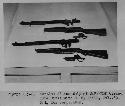

Springfield Armory Museum - Collection Record


Send us your own comments about this object.
| Title: | RIFLE, MILITARY - JAPANESE RIFLE TYPE 5 (COPY OF U.S. M1) 7.7MM SN# 53 |
| Maker/Manufacturer: | GARAND, JOHN C. |
| Date of Manufacture: | 1945 |
| Eminent Figure: | |
| Catalog Number: | SPAR 1900 |
| Measurements: | OL:107.9CM 42 1/4" BL: 58.4CM 23 1/16" |
Object Description:
JAPANESE RIFLE TYPE 5 (COPY OF U.S. M1) 7.7MM SN# 53
Manufactured by Yokosuka Naval Arsenal, Yokosuka, Japan in 1945 - Limited Japanese production copy of M1 Garand. Virtually identical to U.S. piece except has a 10-round magazine and guide for loading from stripper clip. Gas-operated. 6-groove rifling; left hand twist. Tangent leaf rear sight graduated 100 to 1200 meters. Weapon weighs approximately 9 lbs. 2 oz. It is believed parts were made for 250 weapons with 125 actually assembled between 1943 and 1945. Cartridge: 7.7x58mm, rimless.
Markings:
Unidentified Japanese characters penciled in barrel bed of stock. 53 stamped on various parts.
Exhibit label: "TYPE 5 (1945) 7.7 millimeter - During the war the Japanese armed forces made many requests for a semiautomatic rifle similar to the U.S. M1. In 1945 the Japanese Navy experimented with a semiautomatic rifle that would fire a 7.7mm round in a 10-round box magazine."
Springfield Union-New, 23 Jan. 1946 - "JAPS COPIED GARAND RIFLE - Maj. Bernstein Brings Home Sample From Tokyo. Maj. Edwin G. Bernstein has returned to his home in Springfield after 42 months of duty in the Pacific theater. His last assignment was with the 161st Infantry Regiment of the 25th 'Tropic Lightning' Division in Nagoya, Japan. He there served as regimental intelligence officer during six weeks of occupation duty, prior to sailing from Japan in December.
Among Maj. Bernstein's war trophies is a Japanese imitation of the Garand U.S. Army M-1 rifle seized at the Washimo Seiki Sawanina factory at Anjo in the Nagoya zone of occupation.
Previous to his service in Japan, he took part in the fighting in the Philippines where his unit engaged the enemy on the Luzon central plains and at Balete Pass in the Carabello Mountains. He also action in the New Georgia and Guadalcanal campaigns, both as infantry troop leader and staff officer.
During his tour of duty in the Pacific, he served also in Hawaii, New Caledonia, and New Zealand.
He is spending four months terminal leave with his parents, Mr. and Mrs. William Bernstein, 188 Fountain St.
Close examination of the imitation Garand, which proved so effective in the war, revealed that the Japs had made a good copy of the weapon developed by the Springfield man. However, the Japs had not got beyond the testing stage. About 100 rifles were seized by the Americans."
Notes: As early as 1943, the Japanese Imperial Navy requested a weapon with more firepower to arm their paratroopers. The supply of captured M1 rifles at Yokosuka Naval Arsenal were studied. It was believed that if the magazine were redesigned to incorporate a fixed box of 10-round capacity for use with the 7.7mm round, it could be fed utilizing two 5-round stripper clips. The modifications worked, and by April of 1945, the weapon was adopted as the Type 5. It is now believed that these arms were made at the Yokosuka Naval Arsenal, and specifically on the 3rd floor. Veterans who managed to salvage these rare weapons as souvenirs have all stated they were in Yokosuka. It is estimated that no more than 125 of these arms were ever fully assembled.
"Developments undertaken in the 1920s and 1930s with automatic rifles had no lasting results, so the Sino-Japanese war,which began in 1937, was fought with conventional Arisaka rifles. When the Pacific War began in 1941, Japanese troops soon found themselves at a disadvantage against U.S. troops armed with Garands. The navy appears to have provisionally adopted the Type 4 recoil-operated rifle in 1944, based on contemporary Swiss practice, but the weapon was unsuccessful. The problems were eventually solved simply by adapting the Garand for the 7.7mm Japanese semi-rimmed rifle cartridge, but no series production had been undertaken by the end of the war." - Walter
"41st Divison N.G., Northwestern U.S., occupied the Imperial Japanese Naval Arsenal at Kure, Japan, and destroyed much of the material, however, saved items of historical value. (Ref: Call from Mr. Hadlock of Library of Congress)." - Billy Pyle
LOAN HISTORY:
Army #6401
References:
Honeycutt, Fred L. MILITARY RIFLES OF JAPAN 1897-1945. 3rd Ed. Julin Books. Palm Beach Gardens, Fl. 1989.
Walter, John. RIFLES OF THE WORLD. 2nd Ed. Krause Publications. Iola, Wi. 1998.